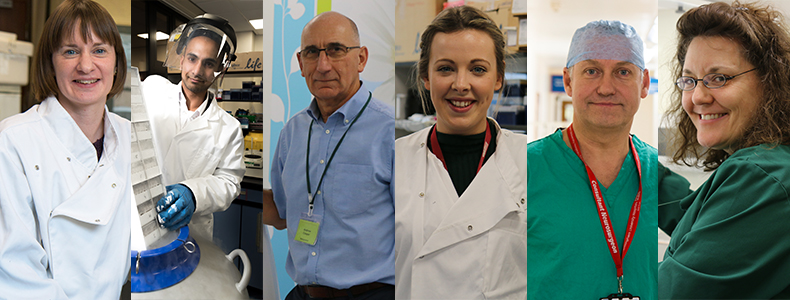 The people behind the papers
The people behind the papers
Meet the researchers creating a brighter future for children with brain tumours.
The Children’s Brain Tumour Research Centre at the Queen’s Medical Centre in Nottingham has treated over 550 children since it opened its doors 20 years ago. The centre is at the forefront of children’s brain tumour research. Specialists from a wide range of departments work together to identify and treat children with brain tumours in new ways that reduce the risks of brain injury and tackle different types of tumours with targeted approaches.
Here, we meet six people who work tirelessly behind the scenes to give every child the bright future they deserve.
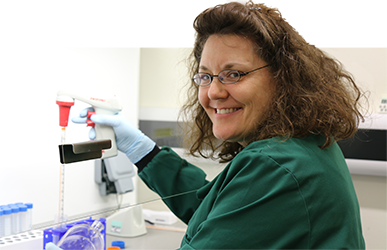
Lisa Storer
Role: Senior Experimental Officer
In three words: Approachable, determined, sensitive.
Favourite place in Nottingham: We always go to the Johnson Arms for lunch when we have something to celebrate, like somebody finishing their PhD.
Hobbies: I’m a Sheffield Wednesday season ticket holder and I enjoy some group classes at the gym.
I was the first employee at the CBTRC 20 years ago, I started as a technician. When I started, my role was to try and bring the hospital’s pathology team into the CBTRC – we needed them to be part of the team so they could provide samples to forward our research.
Without the samples and the joined up working we wouldn’t be where we are today. Now all of the different clinical roles work together, so we’re really one big team now. Now, my role cuts across most of the projects undertaken in the CBTRC labs. I act as the link person between the research in the labs and the clinical information, samples and clinical trials.
Alongside that, I also have some of my own research projects looking into the effect of starving the tumours of dietary glucose and a second looking at the effect of a group of drugs called cannabinoids on children’s brain tumours.
Over the years, I’ve met many inspirational supporters of the CBTRC. It’s thanks to them that we’ve been able to buy new equipment like tissue incubators and a microtome that enables us to cut very thin sections of tissue to study under a microscope. Things like this make a big difference to our work. I’m very passionate about what we do and being able to find solutions to treat children better.
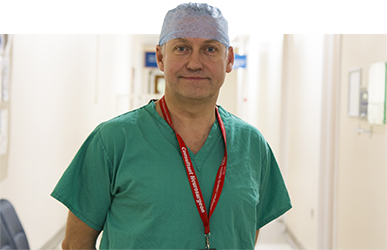
Donald Macarthur
Role: Paediatric Neurosurgeon
In three words: Sociable, medical, musical.
Favourite place in Nottingham: Colwick Park.
Hobbies: Playing saxophone in a hospital band called the Spinal Chords and another band in West Bridgford called the Old Codgers. I also play cricket and occasionally go climbing.
On a typical day I’ll have a mixture of clinics, attending meetings about patients, operating and covering on-call duties. Children’s brain tumours can be very tricky to manage. They’re a very diverse group of tumours and present in all sorts of different ways.
However, we’re now seeing improvements in outcomes and an enhanced understanding of children’s brain tumours and how to treat them.
Operating on the brain can be a challenge – we often need the head to be in a specific position and for young children that means we need specialist equipment. Thanks to the generosity of people who support the CBTRC, we were able to get a head holder for children that we can use for tumour operations.
Children are fantastic to work with. A day or two after surgery they just want to know where the play room is and what’s for lunch, they don’t seem to feel sorry for themselves. But it’s the most terrifying thing for a parent – I just want to give the best deal possible to children with brain tumours.
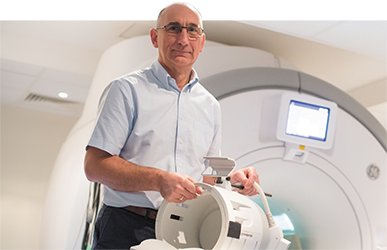 Andrew Cooper
Andrew Cooper
Role: Lead Research Radiographer
In three words: Approachable, laid back, personable.
Favourite place in Nottingham: Wollaton Park.
Hobbies: I like photography and relaxing with warm holidays and scuba diving.
I manage the MRI scanning aspects of the Sir Peter Mansfield Imaging Centre in the Queens Medical Centre. We work on purely research based scanning, taking what’s been done in high end research and bringing it into the clinical domain.
At the moment I’m working on a small research project, looking at taking scans of children’s brains in our upright scanner rather than having to put them sleep with general anaesthetic for a more detailed MRI scan. This means that children and their families will be able to avoid the added stresses of general anaesthetic and the fasting required beforehand, but still get images sufficient to make an initial diagnosis.
Scanning can be a stressful experience for children and their families. Thanks to the support of a number of donors including the Sam White Legacy, we now have a mock MRI scanner that helps us introduce children to the scanner. They can look around it, drive themselves in and out of it and play with it – the children that have done that have managed to go ahead and have their MRI the next day without a general anaesthetic. It’s nice when you can help a child and their parents get over their fears, and the mock scanner has really helped us to do that.
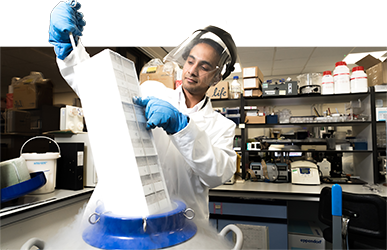
Ruman Rahman
Role: Assistant Professor of Molecular Neuro-Oncology
In three words: Driven, confident, patient.
Favourite place in Nottingham: Attenborough Nature Reserve.
Hobbies: I’m very competitive and have always found an outlet in sport. I play tennis for Attenborough’s Men’s First Team.
I first came to Nottingham to do children’s brain tumour research as part of a three year post-doctoral post in 2007. That post was thanks to supporters of the CBTRC, who also helped when I set up my independent research group in 2011.
I lead a very talented team of PhD students and post-doctoral researchers which has grown massively thanks to the support of several charitable funders. We have a number of projects particularly related to childhood ependymoma. One project aims to see how the cancer metabolises the nutrients around it in ependymoma tumours isolated from surgery. We’re looking at the different regions of the tumour in the hope of finding vulnerabilities that we could target with new therapies – a metabolic Achilles’ heel.
It would be amazing if our biological evidence could be used to help re-purpose a drug – maybe one that hasn’t been used previously to treat cancer – to start a clinical trial to help children here in Nottingham. It’s the full cycle – discovery research to clinical trial to patient treatment and care. The CBTRC is a dynamic and exciting environment and an inspirational place to be.
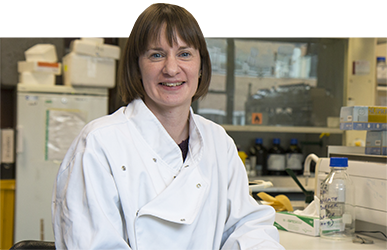
Hazel Rogers
Role: Fighting Ependymoma Senior Research Fellow
In three words: Hard-working, friendly, supportive.
Favourite place in Nottingham: Attenborough Nature Reserve.
Hobbies: I play the trombone in a swing band and a brass band. I also enjoy going hiking.
My research has two main strands – one is analysing tissue from tumours that patients have consented for us to use, the other is using experimental laboratory models to try and work out how we can target tumours at a molecular level therapeutically.
Philanthropy and donations make a big difference to our world. Gifts are supporting some of the projects I’m working on and have helped fund my position at certain times in my
research career. At the moment we’re looking at a specific brain tumour, ependymoma. One of the big problems for children with ependymoma is that it often comes back. In these cases the prognosis decreases quite a lot. Yet we don’t know much about the biology of the relapsed tumour compared to the original.
We’ve been doing a big study to profile that – this work is only possible thanks to the support we’ve had from donors to the CBTRC.
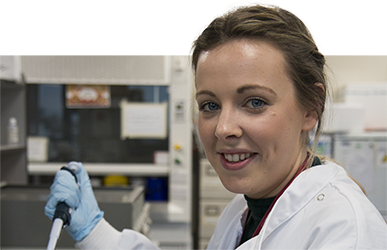
Hannah Jackson
Role: James Tudour Foundation PhD student
In three words: Considerate, friendly, happy.
Favourite place in Nottingham: Newstead Abbey.
Hobbies: Climbing, going to the gym and visiting National Trust places.
I’m a first year PhD student trying to understand why some brain tumours migrate to other parts of the brain, a process known as metastasis. We think that the metastatic cancer cells send out small packages called exosomes that travel ahead of the cancer cells. The exosomes find and prepare new sites for migrating cancer cells to settle. If we can detect and identify these exosomes we can use them to detect metastatic brain tumours earlier.
Exosomes are quite a new area of study. It’s only been in the last 10 years that people have been looking into them and are realising their potential. I always wanted to work in cancer research doing something where I could make a difference. I started by self-funding my masters at the CBTRC, then, thanks to Nottingham Life Cycle 7, we were able to get funding for my PhD.
I love that my work could one day improve the outcome for someone with cancer. It could actually save lives and help children with brain tumours.
---
Thank you to everyone who supports our children's brain tumour research. Children with brain tumours have to fight two battles - firstly for their lives, and then against the lifelong disabilities this disease causes.
Your generosity provides a vital lifeline for our centre and helps us progress multiple research projects simultaneously. Together, we can create a brighter future for children with brain tumours. Thank you.
You may also be interested in:
Living with 'scanxiety'
In the four years that he lived with a brain tumour, Sam White endured more than 25 distressing scans. His parents Mike and Pam share how Sam's experience has helped transform the process for children today.
At the lab bench
Thanks to your support, our breast cancer research is making good progress. We asked our researchers to share how donations are helping them make the next breast cancer breakthrough, faster.
Join us for the launch of the Nottingham Breast Cancer Research Centre
Discover more about our exciting plans for a new research centre, hear talks from patients and researchers and go behind-the-scenes with laboratory tours.